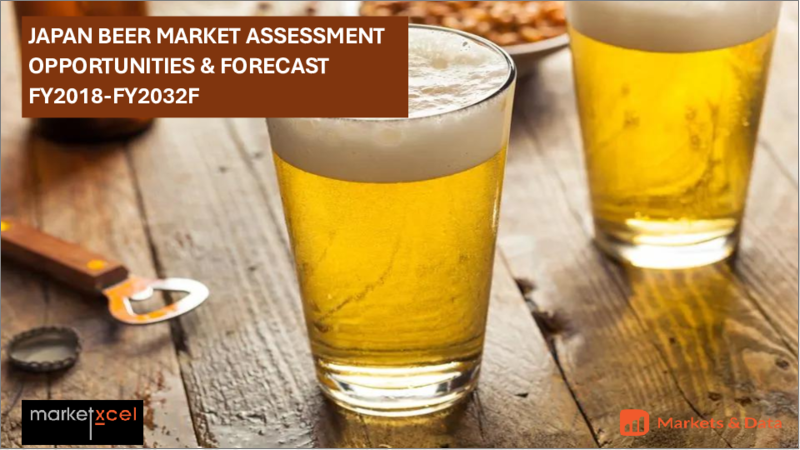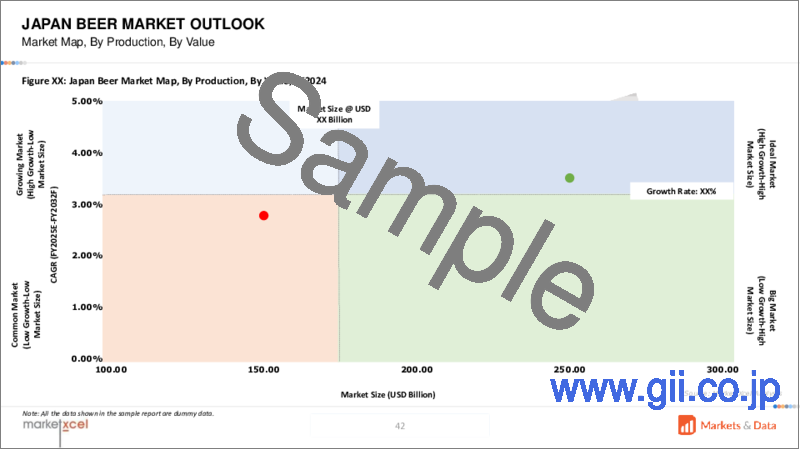|
|
市場調査レポート
商品コード
1486773
ビールの日本市場の評価:製品別、濃度別、品質別、アルコール度数別、低温殺菌別、包装タイプ別、生産別、エンドユーザー別、流通チャネル別、地域別、機会、予測(2018年度~2032年度)Japan Beer Market Assessment, By Product, By Concentration, By Quality, By Alcohol Volume, By Pasteurization, By Packaging Type, By Production, By End-user, By Distribution Channel, By Region, Opportunities and Forecast, FY2018-FY2032F |
||||||
カスタマイズ可能
|
|||||||
| ビールの日本市場の評価:製品別、濃度別、品質別、アルコール度数別、低温殺菌別、包装タイプ別、生産別、エンドユーザー別、流通チャネル別、地域別、機会、予測(2018年度~2032年度) |
|
出版日: 2024年05月29日
発行: Markets & Data
ページ情報: 英文 118 Pages
納期: 3~5営業日
|
全表示
- 概要
- 図表
- 目次
日本のビールの市場規模は、2024年度の286億3,000万米ドルから2032年度までに349億1,000万米ドルに達すると予測され、2025年~2032年度の予測期間にCAGRで2.5%の成長が見込まれます。市場の成長促進要因は、クラフトビール醸造所の増加、スタウト、IPA、ラガーなどの特定のビールスタイルに対する消費者の選好、パーティー、イベント、結婚などの社交的な飲酒の場での消費の増加、醸造所ツアーやビアフェスティバルなどのビールツーリズムの盛り上がり、ビールの味を向上させる醸造技術の革新などです。
Kirin Holdings Companyの推計によれば、日本は世界最大のビール消費国の1つであり、2022年の総消費は42億9,400万リットルに達します。この地域の前年比成長率は2.5%です。このため、さまざまな外資系企業が日本に進出し、収益源を拡大しようとしています。
買収と提携は、ビール市場の主な成長促進要因となっています。主要企業は、その独特な醸造技術と豊かな風味により、クラフトビール醸造所を買収してきました。クラフトビール産業は急速に進化しており、日本のビール市場の成長を大きく促進しています。さらに、買収は規模の経済と経営の効率化を促進し、結果として生産と流通のコストを最小化します。
ホスピタリティ産業が日本のビール市場の成長を促進しています。パブやバーは、消費者がより幅広い種類のビールを試すことを可能にし、ビール市場の拡大に寄与しています。パーティー、フードドライブ、ビアフェスティバル、コンサートなどのソーシャルイベントが市場成長をさらに後押ししています。
さらに、小売流通チャネルは、消費者が製品を入手しやすく、ブランドの認知度が高いため、日本のビール市場の成長を促進しています。例えば、2023年8月、コマースイネーブルメント企業のAnyMind Groupは、日本を拠点とするマルチチャネルネットワークのUUUMと提携し、消費者直接販売のクラフトビールブランド「Sakasuki」をSakasuki公式オンラインストアで発売することを発表しました。
市場成長を支える世界の提携
買収は、さまざまな面でビール市場の成長を大きく後押ししています。買収により、大手ビールメーカーは新たなマーケットプレイスで自社を拡大し、流通チャネルを拡大することができます。買収は、主要企業が国際ビール市場で人気を獲得し、地元地域から比較的大きな市場へと選択肢を拡大するのに役立ちます。
日本のビール市場の主要企業は、国外に事業を拡大し、世界の舞台で日本のビールを代表するために、ビール市場の他企業を買収したり、提携したりしています。例えば、2024年2月、Kirin Holdings Company, Limitedは、クラフトビールブランド「Bira 91」を所有するインドのB9 Beverages Limitedに2,500万米ドルを投資しました。2022年8月には、Sapporo Breweries Limitedが1億6,500万米ドルでStone Brewingの買収を完了しました。この買収により、日本最古のビールブランドは米国市場、すなわちエスコンディード、カリフォルニア州リッチモンド、バージニア州で活動することになります。2024年1月、Asahi Group HoldingsはOctopi Brewingの買収を発表しました。この買収により、日本でもっとも有名なビールであるAsahi Super Dryが初めて米国で醸造されることになります。
市場成長を促進するクラフトビール
クラフトビールが消費者に好まれる理由は、そのユニークな醸造技術、職人的な味わい、豊かな風味にあります。日本の消費者は、クラフトビールに関連する品質、信頼性、職人技をますます重視するようになっています。さらに、革新的なレシピと醸造技術によってクラフトビールメーカーが提供する、風味やユニークな味のプロファイルを探求することへの消費者の関心の高まりが、市場成長を促進しています。このように、日本の消費者によるクラフトビールへの選好の高まりが、市場に機会をもたらしています。
当レポートでは、日本のビール市場について調査分析し、市場規模と予測、市場力学、主要企業の情勢と見通しなどを提供しています。
目次
第1章 調査手法
第2章 プロジェクトの範囲と定義
第3章 エグゼクティブサマリー
第4章 顧客の声
- 人口統計(年齢/コホート分析 - ベビーブーマー世代、X世代、ミレニアル世代、Z世代、性別、所得 - 低所得、中所得、高所得、地域、国籍など)
- 製品と市場情報
- ブランド認知の方式
- 購入決定において考慮される要素
- プライバシーと安全規制の考慮
- 購入チャネル
- 購入頻度
- 既存または想定されるユーザー
- 友人や家族からの推奨/オンラインレビュー
- ブランドアンバサダーやインフルエンサーマーケティングが製品/ブランドの浸透に果たす役割
第5章 日本のビール市場の見通し(2018年度~2032年度)
- 市場規模と予測
- 金額
- 数量
- 製品別
- ラガー
- エール
- ハイブリッド
- その他
- 濃度別
- ストロング
- マイルド
- 品質別
- スタンダード
- プレミアム
- アルコール度数別
- 5%以下
- 10%超
- 低温殺菌別
- 低温殺菌ビール
- 非低温殺菌ビール
- 包装タイプ別
- 瓶
- 缶
- その他
- 生産別
- マクロ醸造所
- マイクロ醸造所
- クラフトビール醸造所
- エンドユーザー別
- 商業
- 住宅
- 流通チャネル別
- オフライン
- オンライン
- 地域別
- 北東部
- 南西部
- 西部
- 中西部
- 南東部
- 市場シェア:企業別(2024年度)
第6章 市場マッピング(2024年度)
- 製品別
- 濃度別
- 品質別
- アルコール度数別
- 低温殺菌別
- 包装タイプ別
- 生産別
- エンドユーザー別
- 流通チャネル別
- 地域別
第7章 マクロ環境と産業構造
- 需給分析
- 輸入輸出分析
- バリューチェーン分析
- PESTEL分析
- ポーターのファイブフォース分析
第8章 市場力学
- 成長促進要因
- 成長抑制要因(課題、抑制要因)
第9章 主要企業の情勢
- マーケットリーダー上位5社の競合マトリクス
- マーケットリーダー上位5社の市場収益分析(2024年度)
- 合併と買収/合弁事業(該当する場合)
- SWOT分析(市場企業5社)
- 特許分析(該当する場合)
第10章 価格分析
第11章 ケーススタディ
第12章 主要企業の見通し
- Heineken Japan KK
- Products and Services
- Sapporo Breweries Limited
- Asahi Group Japan, Ltd.
- Suntory Holdings Limited
- AB InBev Japan LLC
- Kirin Holdings Company, Limited
- Baird Brewing Company
- Echigo Beer Co., Ltd
- Diageo Japan K.K.
- Orion Breweries, Ltd
第13章 戦略的推奨
第14章 当社について、免責事項
List of Tables
- Table 1. Pricing Analysis of Products from Key Players
- Table 2. Competition Matrix of Top 5 Market Leaders
- Table 3. Mergers & Acquisitions/ Joint Ventures (If Applicable)
- Table 4. About Us - Regions and Countries Where We Have Executed Client Projects
List of Figures
- Figure 1.Japan Beer Market, By Value, FY2018-FY2032F
- Figure 2.Japan Beer Market, By Volume, In Gallons, In USD Billion, FY2018-FY2032F
- Figure 3.Japan Beer Market Share (%), By Product, FY2018-FY2032F
- Figure 4.Japan Beer Market Share (%), By Concentration, FY2018-FY2032F
- Figure 5.Japan Beer Market Share (%), By Quality, FY2018-FY2032F
- Figure 6.Japan Beer Market Share (%), By Alcohol Volume, FY2018-FY2032F
- Figure 7.Japan Beer Market Share (%), By Pasteurization, FY2018-FY2032F
- Figure 8.Japan Beer Market Share (%), By Packaging Type, FY2018-FY2032F
- Figure 9.Japan Beer Market Share (%), By Production, FY2018-FY2032F
- Figure 10.Japan Beer Market Share (%), By End-User, FY2018-FY2032F
- Figure 11.Japan Beer Market Share (%), By Distribution Channel, FY2018-FY2032F
- Figure 12.Japan Beer Market Share (%), By Region, FY2018-FY2032F
- Figure 13.By Product Map-Market Size (USD Billion) & Growth Rate (%), FY2024
- Figure 14.By Concentration Map-Market Size (USD Billion) & Growth Rate (%), FY2024
- Figure 15.By Quality Map-Market Size (USD Billion) & Growth Rate (%), FY2024
- Figure 16.By Alcohol Volume Map-Market Size (USD Billion) & Growth Rate (%), FY2024
- Figure 17.By Pasteurization Map-Market Size (USD Billion) & Growth Rate (%), FY2024
- Figure 18.By Packaging Type Map-Market Size (USD Billion) & Growth Rate (%), FY2024
- Figure 19.By Production Map-Market Size (USD Billion) & Growth Rate (%), FY2024
- Figure 20.By End-User Map-Market Size (USD Billion) & Growth Rate (%), FY2024
- Figure 21.By Distribution Channel Map-Market Size (USD Billion) & Growth Rate (%), FY2024
- Figure 22.By Region Map-Market Size (USD Billion) & Growth Rate (%), FY2024
Japan beer market is projected to witness a CAGR of 2.5% during the forecast period FY2025-FY2032, growing from USD 28.63 billion in FY2024 to USD 34.91 billion in FY2032. The factors which drive the growth of the market includes a growing number of craft breweries, consumers' preference for specific beer styles, such as stouts, IPAs, or lagers, increasing consumption in social drinking occasions such as parties, events, and marriages, along with the boost in beer tourism, including brewery tours and beer festivals and innovation in the brewing techniques enhancing the taste of the beer.
As per the estimations of Kirin Holdings Company, Limited, Japan is one of the largest consumers of beer globally, with a total consumption of 4,294 million liters in 2022. The region is showing a year-on-year growth rate of 2.5%. This is attracting various foreign companies to establish themselves in Japan and increase their revenue streams.
Acquisitions and collaborations have been key factors in facilitating the growth of the beer market. Key players have been acquiring craft breweries due to their distinct brewing techniques and rich flavor. The craft beer industry has been evolving rapidly, significantly driving the growth of the Japan beer market. Moreover, acquisitions promote economies of scale and efficiency in operations, resulting in the minimization of production and distribution costs.
The hospitality industry is fostering the growth of Japan's beer market. Pubs and bars enable consumers to try out a wider range of beers, contributing to the expansion of the beer market. Social events such as parties, food drives, beer festivals, and concerts further support the market growth.
Furthermore, the retail distribution channel is fostering Japan's beer market growth due to the ease of product availability for consumers and better brand visibility. For instance, in August 2023, AnyMind Group, a commerce enablement company, partnered with UUUM, a Japan-based multi-channel network, to announce the launch of their direct-to-consumer craft beer brand, Sakasuki, on the official Sakasuki online store.
Global Collaborations to Support the Market Growth
Acquisitions are majorly driving the beer market growth in numerous aspects. Acquisitions enable giant and large beer manufacturers to expand themselves in the newer marketplaces and extend their distribution channels, enabling them to reach more consumers and increase their market share. Acquisitions help the key players gain popularity in international beer markets and expand their options from the local region to a relatively larger marketplace.
The major players in the Japanese beer market are acquiring and collaborating with other players in the beer market to expand their operations overseas and represent Japanese beer on a global stage. For instance, in February 2024, Kirin Holdings Company, Limited invested USD 25 million in India's B9 Beverages Limited, owner of the craft beer brand Bira 91. In August 2022, Sapporo Breweries Limited closed an acquisition of Stone Brewing for USD 165 million. With this acquisition, the oldest Japanese beer brand will carry its operation in the United States markets, namely, Escondido, Richmond, California, and Virginia. In January 2024, Asahi Group Holdings, Limited announced the acquisition of Octopi Brewing. With the help of the acquisition, Asahi Super Dry, which is Japan's most famous beer will now be brewed in the United States for the very first time.
Craft-Beer Driving the Market Growth
Craft breweries are preferred by the consumers because of their unique techniques of brewing, artisanal taste, and rich flavors. Japanese consumers are increasingly valuing quality, authenticity, and craftsmanship which is associated with the craft beer. Moreover, consumers' growing interest in exploring flavors and unique taste profiles which are often offered by the craft breweries due to their innovative recipes and brewing techniques is driving the market growth. Thus, the increasing preference by Japanese consumers for craft beers is offering an opportunity in the market.
Various players from different regions are expanding their operation and establishing themselves in Japan, witnessing the growth opportunities of beer in the region. Foreign craft brewers recognize the potential for partnership with local restaurants, bars, and retailers, enabling them to promote their brand in the region.
In January 2024, Great Dane Pub and Brewing Company, a U.S. based craft brewer announced the establishment of a brewhouse in Sendai, Japan. The latest brewhouse launched with two locally brewed beers, namely, Amber Ale and Great Lager. Great Dane Brewing Japan is the first foreign-owned brewer in Japan with a bricks-and-mortar brewery.
Standard Beer Dominates Japan Beer Market Share
Standard beer dominates the Japanese beer market over the premium beer market due to the Japanese government's high liquor taxation. Due to the rise in prices, consumers gradually started shifting to other types of liquors or towards cheaper-quality beer. Moreover, the heavy taxation on beer by the Japanese government has prompted the production of lower-tax alternatives such as Happoshu or other low-malt beers.
The lower quality substitutes have been dominating Japan beer market since past three decades. Additionally, consumers might find beer less affordable due to the high tax rate, which is hindering the market growth, as a solution to which manufacturers are introducing standard and low malt beer for the consumers. For instance, in April 2024, Kirin Holdings Company, Limited introduced Harekaze, a standard priced beer. The latest beer offered by the company provides consumers with a unique drinking experience without the accompanying sourness which is typically associated with such beverages.
Future Market Scenario (FY2025 - FY2032F)
In the latest market trend, the Japanese government has planned to introduce liquor tax reforms, which will reduce the taxes levied on beer. The latest national liquor tax law applied by the Japanese government in 2017 impacted the liquor tax rates for beer in Japan in three stages over a decade, starting from 2017 until 2026.
The tax lowering has been implemented to improve the quality of Japan's brews. The Japan liquor tax is divided into three different categories, but it will be unified into a single category in 2026. As a result, the liquor tax on malt-based beer (not less than 25% malt) will be lowered, and the rate for beer-flavored liquors (25% malt) will be increased.
Key Players Landscape and Outlook
Key players are helping in the growth of the market by focusing on continuous product innovation, retail expansions, and strategic marketing. The manufacturers are actively expanding their product portfolio, increasing the base of the customers, and catering to their evolving needs.
The key players are expanding their productive capacities by establishing new production units and plants. For instance, in November 2023, Asahi Group Japan, Ltd. announced that it will soon launch its latest brewery in Tosu, Saga Prefecture, Japan. The establishment is scheduled to be inaugurated in 2029. Through this expansion, the company intends to produce a variety of beverages, including beer and soft drinks. Moreover, the Tosu plant is expected to handle a substantial portion of shipments for Kyushu, the southwestern region of Japan's main island.
Table of Contents
1.Research Methodology
2.Project Scope and Definitions
3.Executive Summary
4.Voice of Customer
- 4.1.Demographics (Age/Cohort Analysis - Baby Boomers and Gen X, Millennials, Gen Z; Gender; Income - Low, Mid and High; Geography; Nationality; etc.)
- 4.2.Product and Market Intelligence
- 4.3.Mode of Brand Awareness
- 4.4.Factors Considered in Purchase Decisions
- 4.4.1.Quality
- 4.4.2.Taste
- 4.4.3.Brand Image
- 4.4.4.Product Variety and Range
- 4.4.5.Innovation
- 4.4.6.Price
- 4.4.7.Availability and Accessibility
- 4.4.8.Promotional Discounts
- 4.5.Consideration of Privacy and Safety Regulations
- 4.6.Purchase Channel
- 4.7.Frequency of Purchase
- 4.8.Existing or Intended User
- 4.9.Recommendations from friends, family/online reviews
- 4.10.Role of Brand Ambassador or Influencer Marketing on Product/Brand Absorption
5.Japan Beer Market Outlook, FY2018-FY2032F
- 5.1.Market Size & Forecast
- 5.1.1.By Value
- 5.1.2.By Volume
- 5.2.By Product
- 5.2.1.Lager
- 5.2.2.Ale
- 5.2.3.Hybrid
- 5.2.4.Others
- 5.3.By Concentration
- 5.3.1.Strong
- 5.3.2.Mild
- 5.4.By Quality
- 5.4.1.Standard
- 5.4.2.Premium
- 5.5.By Alcohol Volume
- 5.5.1.0%
- 5.5.2.Up to 5%
- 5.5.3.5%-10%
- 5.5.4.More than 10%
- 5.6.By Pasteurization
- 5.6.1.Pasteurized Beer
- 5.6.2.Non-pasteurized Beer
- 5.7.By Packaging Type
- 5.7.1.Bottles
- 5.7.2.Cans
- 5.7.3.Others
- 5.8.By Production
- 5.8.1.Macro-Brewery
- 5.8.2.Micro-Brewery
- 5.8.3.Craft-Brewery
- 5.9.By End-user
- 5.9.1.Commercial
- 5.9.2.Residential
- 5.10.By Distribution Channel
- 5.10.1.Offline
- 5.10.1.1.Liquor Stores
- 5.10.1.2.Bars
- 5.10.1.3.Brewery
- 5.10.1.4.Hotels and Restaurants
- 5.10.1.5.Supermarkets and Hypermarkets
- 5.10.1.6.Others
- 5.10.2.Online
- 5.10.1.Offline
- 5.11.By Region
- 5.11.1.Northeast
- 5.11.2.Southwest
- 5.11.3.West
- 5.11.4.Midwest
- 5.11.5.Southeast
- 5.12.By Company Market Share (%), FY2024
6.Market Mapping, FY2024
- 6.1.By Product
- 6.2.By Concentration
- 6.3.By Quality
- 6.4.By Alcohol Volume
- 6.5.By Pasteurization
- 6.6.By Packaging Type
- 6.7.By Production
- 6.8.By End-user
- 6.9.By Distribution Channel
- 6.10.By Region
7.Macro Environment and Industry Structure
- 7.1.Demand Supply Analysis
- 7.2.Import Export Analysis
- 7.3.Value Chain Analysis
- 7.4.PESTEL Analysis
- 7.4.1.Political Factors
- 7.4.2.Economic System
- 7.4.3.Social Implications
- 7.4.4.Technological Advancements
- 7.4.5.Environmental Impacts
- 7.4.6.Legal Compliances and Regulatory Policies (Statutory Bodies Included)
- 7.5.Porter's Five Forces Analysis
- 7.5.1.Supplier Power
- 7.5.2.Buyer Power
- 7.5.3.Substitution Threat
- 7.5.4.Threat from New Entrant
- 7.5.5.Competitive Rivalry
8.Market Dynamics
- 8.1.Growth Drivers
- 8.2.Growth Inhibitors (Challenges and Restraints)
9.Key Players Landscape
- 9.1.Competition Matrix of Top Five Market Leaders
- 9.2.Market Revenue Analysis of Top Five Market Leaders (in %, FY2024)
- 9.3.Mergers and Acquisitions/Joint Ventures (If Applicable)
- 9.4.SWOT Analysis (For Five Market Players)
- 9.5.Patent Analysis (If Applicable)
10.Pricing Analysis
11.Case Studies
12.Key Players Outlook
- 12.1.Heineken Japan KK
- 12.1.1.Company Details
- 12.1.2.Key Management Personnel
- 12.1.3.Products and Services
- 12.1.4.Financials (As reported)
- 12.1.5.Key Market Focus and Geographical Presence
- 12.1.6.Recent Developments
- 12.2.Sapporo Breweries Limited
- 12.3.Asahi Group Japan, Ltd.
- 12.4.Suntory Holdings Limited
- 12.5.AB InBev Japan LLC
- 12.6.Kirin Holdings Company, Limited
- 12.7.Baird Brewing Company
- 12.8.Echigo Beer Co., Ltd
- 12.9.Diageo Japan K.K.
- 12.10.Orion Breweries, Ltd
Companies mentioned above DO NOT hold any order as per market share and can be changed as per information available during research work.





